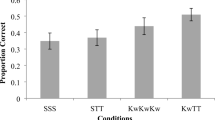Abstract
This study evaluates the effectiveness of a mnemonic procedure, called the keyword method, for teaching a large Russian language vocabulary to college students. The method divides the study of a vocabulary item into two stages. The first stage requires the student to associate the spoken Russian word with an English word (the keyword) that sounds like some part of the foreign word; the second stage requires the student to form a mental image of the keyword “interacting” with the English translation. Thus, the keyword method can be described as a chain of two links connecting a foreign word to its English translation through the mediation of a keyword: the foreign word is linked to a keyword by a similarity in sound (acoustic link), and the keyword is linked to the English translation by a mental image (imagery link). A computer controlled curriculum using the keyword method served as a supplement to the second-year Russian language course at Stanford University. Students studied a large basic vocabulary over an 8 to 10-week period. Data obtained during the study and student reports indicate that the keyword method was highly effective.
Similar content being viewed by others
References
Atkinson, R. C. “Ingredients for a theory of instruction.” American Psychologist, 1972, 27, 921–931.
Atkinson, R. C. Mnemotechnics in second-language learning. American Psychologist, 1975, 30: 821–828.
Atkinson, R. C. “Adaptive instructional systems: Some attempts to optimize the learning process.” In D.Klahr (Ed.), Cognition and instruction, Hillsdale, N. J.: Erlbaum, 1976.
Atkinson, R. C., Bower, G. H. and Crothers, E. J. An Introduction to Mathematical Learning Theory. New York: Wiley, 1965.
Atkinson, R. C. and Paulson, J. A. “An approach to the psychology of instruction.” Psychological Bulletin, 1972. 78, 49–61.
Atkinson, R. C. and Raugh, M. R. “An application of the mnemonic keyword method to the acquisition of a Russian vocabulary.” Journal of Experimental Psychology, 1975, 104, 126–133.
Atkinson, R. C. and Shiffrin, R. M. “Human memory:A proposed system and its control processes.” In K. W.Spence and J. T.Spence (Eds.), The psychology of learning and motivation. Vol. II. New York: Academic Press, 1968.
Holley, F. M. “A study of vocabulary in context: The effect of new-word density in German reading materials.” Foreign Language Annals, 1973, 6, 339–347.
Hughes, J. P. Linguistics and Language Teaching. New York: Random House, 1968.
Ott, C. E., Butler, D. C., Blake, R. S. and Ball, J. P. “The effect of interactive-image elaboration on the acquisition of foreign language vocabulary.” Language Learning, 1973, 23, 197–206.
Raugh, M. R. and Atkinson, R. C. “A mnemonic method for learning a second-language vocabulary.” Journal of Eductional Psychology, 1975, 67, 1–16.
Yates, F. The art of memory. Chicago: University of Chicago Press, 1972.
Additional information
Stanford University
Rights and permissions
About this article
Cite this article
Raugh, M.R., Schupbach, R.D. & Atkinson, R.C. Teaching a large Russian language vocabulary by the mnemonic keyword method. Instr Sci 6, 199–221 (1977). https://doi.org/10.1007/BF00120656
Issue Date:
DOI: https://doi.org/10.1007/BF00120656




